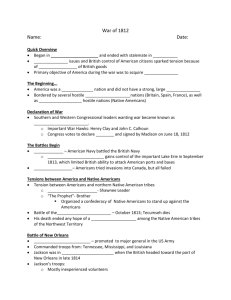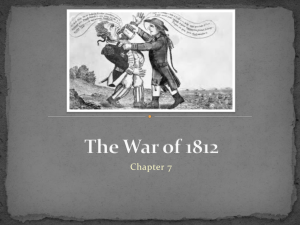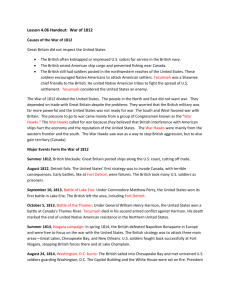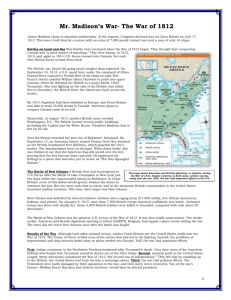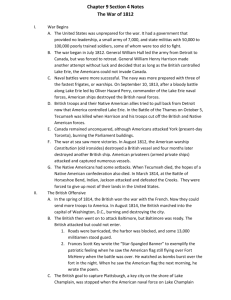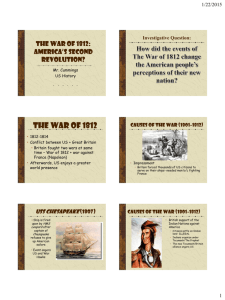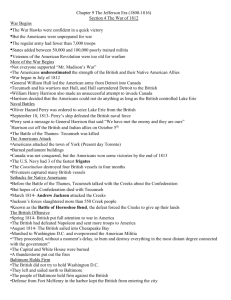War of 1812 Battles
advertisement
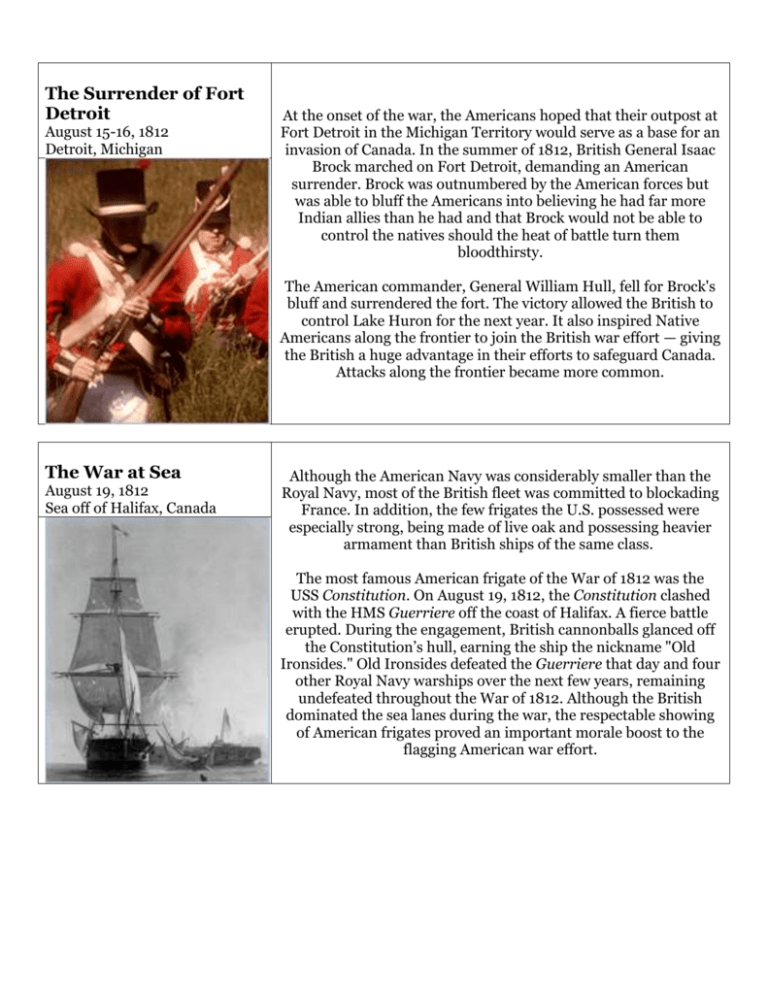
The Surrender of Fort Detroit August 15-16, 1812 Detroit, Michigan At the onset of the war, the Americans hoped that their outpost at Fort Detroit in the Michigan Territory would serve as a base for an invasion of Canada. In the summer of 1812, British General Isaac Brock marched on Fort Detroit, demanding an American surrender. Brock was outnumbered by the American forces but was able to bluff the Americans into believing he had far more Indian allies than he had and that Brock would not be able to control the natives should the heat of battle turn them bloodthirsty. The American commander, General William Hull, fell for Brock's bluff and surrendered the fort. The victory allowed the British to control Lake Huron for the next year. It also inspired Native Americans along the frontier to join the British war effort — giving the British a huge advantage in their efforts to safeguard Canada. Attacks along the frontier became more common. The War at Sea August 19, 1812 Sea off of Halifax, Canada Although the American Navy was considerably smaller than the Royal Navy, most of the British fleet was committed to blockading France. In addition, the few frigates the U.S. possessed were especially strong, being made of live oak and possessing heavier armament than British ships of the same class. The most famous American frigate of the War of 1812 was the USS Constitution. On August 19, 1812, the Constitution clashed with the HMS Guerriere off the coast of Halifax. A fierce battle erupted. During the engagement, British cannonballs glanced off the Constitution’s hull, earning the ship the nickname "Old Ironsides." Old Ironsides defeated the Guerriere that day and four other Royal Navy warships over the next few years, remaining undefeated throughout the War of 1812. Although the British dominated the sea lanes during the war, the respectable showing of American frigates proved an important morale boost to the flagging American war effort. The Battle of Queenston Heights October 13, 1812 Queenston Heights, Canada In October 1812, American forces planned to invade Canada below Niagara Falls at Queenston Heights. The attack on October 13, which was the first major battle of the war, was initially successful, with the Americans driving the British from the heights. But the victory would not last long. Militia troops from New York, who saw the battle’s destruction, refused to participate in the invasion by crossing into Canada. This left the U.S. Army exposed and outnumbered. British General Isaac Brock led reinforcements and a contingent of Native Americans in a counterattack up the hill. Though Brock lost his life in the attack, his troops succeeded in taking Queenston Heights back from the Americans. Brock was memorialized and romanticized as a hero in British history, and the victory helped provide unity and identity to what would later be Canada. The American forces would have to wait longer to win their first major battle of the war. The Battle of Lake Erie September 10, 1813 Lake Erie off the coast of Ohio Control of the waterways and Great Lakes was vital to both sides during the War of 1812. The balance of power shifted as both Britain and the United States raced to build more and more ships along the Great Lakes. Eventually, a confrontation occurred on Lake Erie when Commodore Oliver Hazard Perry engaged a British force. A fleet of six British ships waited for him. Over three hours of fierce fighting forced Perry to abandon his fleet's flagship using an open rowboat. Perry then boarded the American ship Niagara, where he continued to lead the fight. Eventually, the British surrendered, making the Battle of Lake Erie the first U.S. defeat of an entire British squadron. Perry famously summed up the victory by writing in his victorious report, "We have met the enemy and they are ours." The Battle of the Thames October 5, 1813 Thamesville, Ontario The American victory at Lake Erie cut off the British supply ships in the Northwest. Unable to feed his army, British General Henry Procter decided to abandon Forts Detroit and Malden. He began an eastward retreat. The Shawnee warrior-leader Tecumseh, who had been fighting alongside Proctor, objected to the retreat but had no alternative except to go along with the plan. The poor morale in Proctor’s army was made worse by bad weather. American General William Henry Harrison cut the enemy retreat short. Harrison attacked the British and Native American forces at Thamesville in Ontario, Canada, about 50 miles east of Detroit. A rash cavalry charge by the Kentucky militia forced the British infantry to scatter quickly. Tecumseh refused to retreat and instead stood his ground. Earlier he had told Procter, "Our lives are in the hands of the Great Spirit. We are determined to defend our lands, and if it is his will, we wish to leave our bones upon them." Tecumseh was killed at Thamesville, ending any hope for a confederacy among the Native American tribes of the Northwest Territory. As a result, the Americans retook Fort Detroit. The Battle of Horseshoe Bend March 27, 1814 Daviston, Mississippi Territory In the South, the Creek Indians of Georgia and Alabama disagreed about which side to take during the war. Southern tribe members favoring assimilation with white culture, siding with the Americans, while the northern group, known as the Upper Creeks, wanted to remain faithful to traditional ways, preferring the British and Spanish. A civil war within the Creek nation, exacerbated by the Americans and British, erupted into the “Creek War” in 1813, when Creek warriors sacked Fort Mims in what is now Alabama, killing 250 militia and settlers. For much of that year and into 1814, U.S. forces under Andrew Jackson waged a bloody campaign in the South. Few prisoners were taken on either side. Finally, on March 27, 1814, American General Andrew Jackson and his Tennessee militia met the Upper Creeks along the Tallapoosa River at Horseshoe Bend. The Creeks had mistakenly positioned themselves on a peninsula that jutted into the river, where Jackson’s men and his Cherokee allies trapped them. More than 800 Upper Creeks were killed, while the U.S. lost only 26 militiamen. The Creek force in the South was broken and forced by the U.S. government to cede millions of acres of land to the United States. The Burning of Washington, D.C. August 24, 1814 Washington, D.C. The Battle of Lake Champlain September 11, 1814 Plattsburgh Bay On August 24, 1814, British troops defeated a group of inexperienced American militiamen at the battle of Bladensburg, Maryland. The British then marched on to Washington, D.C., just seven miles away, which had been deserted as most of its residents had fled. Before the night was out, both the White House and the Capitol building had been torched. While President James Madison had left the city earlier to witness the battle at Bladensburg, his young wife, Dolley Madison, had stayed behind. As the British forces advanced on the capital, the first lady rushed to save her husband's official documents. She also instructed her butler “French John” to save the portrait of George Washington painted by Gilbert Stuart. The Napoleonic Wars were over by April 1814. The British were suddenly free to concentrate their forces on the war in America. In the northern border theater, British General George Prevost set off for the American garrison at Plattsburgh. Prevost commanded an army of 11,000 men. The American forces at Plattsburgh numbered only 1,500. Had Prevost struck immediately, he would have taken the fort easily. But instead, the general decided to wait for British naval forces to defeat the American flotilla on the lake. Without securing the lake first, Prevost would have no way to provision his army. The American naval forces held a good defensive position in Plattsburgh Bay and defeated the British attackers. Without the fleet, Prevost ordered the land forces to disengage and withdraw to Canada, a decision for which he was criticized since he could have effortlessly captured the fort. The win at Lake Champlain secured America's northern border. It also strengthened the Americans’ position when it came time to negotiate for the war's end. The Bombing of Fort McHenry September 13, 1814 Baltimore, Maryland After taking Washington, D.C., British commanders set their sights on Baltimore, a valuable port city 45 miles to the northeast. Baltimore was renowned for its hatred of the British and was significantly more prepared than Washington, D.C. for the attack, having fortified the city and brought in extra manpower. On September 13, 1814, the British fleet began bombarding Fort McHenry, which was nestled in the city's inner harbor. The British bombed the fort for 25 hours. Meanwhile, the people of Baltimore waited to see if the fort – and its flag — would stand. Among those watching was Francis Scott Key, a lawyer and amateur poet. As the smoke cleared on the morning of September 14, Key saw that the fort had held and the flag was still there. He began writing the words that would later become America's National Anthem: "O say can you see, by the dawn's early light, what so proudly we hailed at the twilight's last gleaming." The successful defense of Baltimore proved an important morale victory and redeemed the loss of the U.S. Capital only two weeks earlier. The Battle of New Orleans January 8, 1815 New Orleans, Louisiana The Treaty of Ghent, signed in what is now Belgium, set the terms for ending the war on December 24, 1814. But according to the treaty, the war would not end until it had been ratified by the U.S. government. In the southern theater, where news of the treaty had not yet reached, war raged on into January 1815. In December, British forces had arrived in the Gulf Coast and met General Andrew Jackson's American army near New Orleans. After a series of battles, the British attacked Jackson’s line on January 8, 1815. Well protected behind a canal, Jackson’s men inflicted over 2,000 casualties upon the British in 30 minutes while losing only 13 men. The British leader, Sir Edward Michael Pakenham, was killed. The U.S. forces secured New Orleans in one of the most lopsided victories in the War of 1812. The war ended on February 16, 1815. News traveled slowly and most Americans heard about the success at New Orleans at the same time, leading many to believe that the United States had won the War of 1812. Jackson became a war hero — and later the president of the United States.

